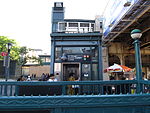The original Yankee Stadium was a stadium located in the Bronx, New York City. It was the home ballpark of the New York Yankees, one of the city's Major League Baseball franchises, from 1923 to 2008, except for 1974-75 when the stadium was renovated. It hosted 6,581 Yankees regular season home games during its 85-year history. It was also the home of the New York Giants National Football League (NFL) team from 1956 through September 1973. The stadium's nickname, "The House That Ruth Built", is derived from Babe Ruth, the baseball superstar whose prime years coincided with the stadium's opening and the beginning of the Yankees' winning history. It has often been referred to as "The Cathedral of Baseball".
The stadium was built from 1922 to 1923 for $2.4 million ($34.4 million in 2022 dollars). Its construction was paid for entirely by Yankees owner Jacob Ruppert, who was eager to have his own stadium after sharing the Polo Grounds with the New York Giants baseball team the previous ten years. Located only a half-mile (0.8 km) north of the upper Manhattan location of the Polo Grounds, Yankee Stadium opened for the 1923 season and was hailed at the time as a one-of-a-kind facility in the country. Over the course of its history, Yankee Stadium became one of the most famous venues in the United States, having hosted a variety of events and historic moments during its existence. While many of these moments were baseball-related—including World Series games, no-hitters, perfect games, and historic home runs—the stadium also hosted boxing matches, the 1958 NFL Championship Game (referred to as The Greatest Game Ever Played), college football, concerts, Jehovah's Witnesses conventions (see record attendance), and three Papal Masses. The stadium went through many alterations and playing surface configurations over the years. The condition of the facility worsened in the 1960s and 1970s, prompting its closure for renovation from October 1973 through 1975. The renovation significantly altered the appearance of the venue and reduced the distance of the outfield fences.In 2006, the Yankees began building a new $2.3 billion stadium on public parkland adjacent to the stadium, which included $1.2 billion in public subsidies. The design includes a replica of the frieze along the roof that had been part of the original Yankee Stadium. Monument Park, a Hall of Fame for prominent former Yankees, was relocated to the new stadium. Yankee Stadium closed following the 2008 season and the new stadium opened in 2009, adopting the "Yankee Stadium" moniker. The original Yankee Stadium was demolished in 2010, two years after it closed, and the 8-acre (3.2 ha) site was converted into a public park called Heritage Field.







